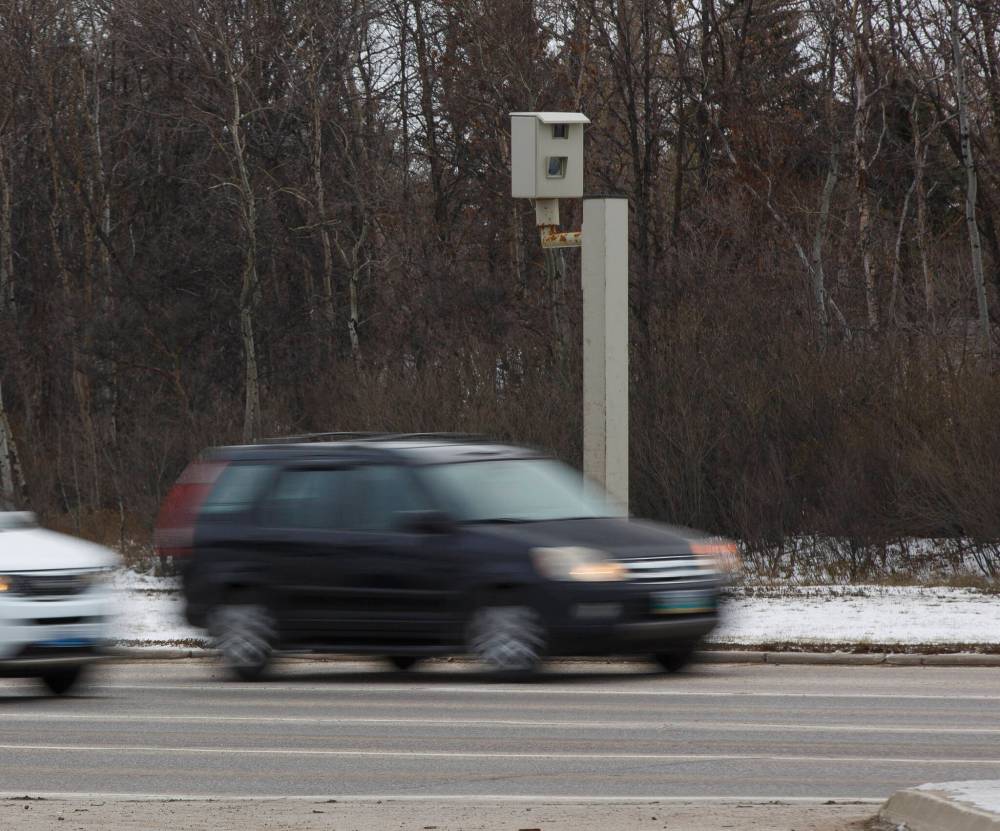Before the provincial government grants the City of Winnipeg permission to deploy photo radar anywhere it chooses, it should ask the question: does it really reduce collisions and injuries?
The answer to that question is that no one knows, because the city refuses to collect collision data where photo radar is used.
There are some statistics for intersection safety cameras (or “red-light cameras” as they’ve come to be known), but they’re incomplete. The data shows that overall collisions are down at the 12 original intersection camera locations compared to when the program began in 2003.

The city is calling on the provincial government to amend the Highway Traffic Act to allow photo radar deployment on any street or roadway. (Mike Deal / Free Press files)
Adjusted for the increase in the number of vehicles on the road since then, overall collisions are down 23 per cent at those locations, according to the Winnipeg Police Service 2023 photo-enforcement annual report. There is no comparative data for the other 37 intersection-camera locations.
The data also shows that right-angle collisions were higher in 2022 and 2023 (adjusted for vehicle growth) at the 12 original locations than in 2003 and 2004. So is it working? Are intersection cameras reducing collisions and injuries? It depends what statistics police cherry-pick.
However, there is no crash data whatsoever for mobile photo-radar units. There is no mechanism to determine whether that program is achieving its stated objective of reducing collisions and injuries.
For the record, this is what it says in the photo-radar annual report: “The goal of the Photo Enforcement Program is to decrease speed related fatalities, collisions and injuries.”
So how does the city know whether photo radar is achieving that goal? It doesn’t.
It could collect that data if it wanted to. The crash data exists where photo radar is used, but police and the city choose not to collect it. The question is, why?
If photo radar was, indeed, about improving road safety, it would be deployed mostly in high-collision areas, data would be collected over time to determine whether it was reducing crashes and injuries at those locations and those statistics would be published every year in the photo-enforcement annual report. But they aren’t.
The reality is that photo radar or, at least, the way it’s used in Winnipeg, has little, if anything, to do with road safety and everything to do with generating revenue for the city. It’s a money-maker, pure and simple.
That’s why mobile photo-radar vehicles are often parked in proven money-making locations, not necessarily in high-crash areas.
The city, once again, is calling on the provincial government to amend the Highway Traffic Act to allow photo radar deployment on any street or roadway. It has made this request in the past and has been turned down.
Right now, under the act, photo radar can be deployed only in school, playground and construction zones. Police brass have, for years, been asking to use it anywhere they want. They claim it’s to improve road safety but they refuse to collect the data necessary to show whether it actually reduces collisions and injuries.
Before the province decides whether to grant the city its wish to expand photo radar, it should first demand that city hall conduct a thorough study of photo radar to determine whether it’s achieving its stated objective. It should have to prove that the program is not just about the money.
Included in that report should be an analysis on whether police are relying more on photo radar and less on traditional traffic-enforcement than they used to.
Police have said in the past that they have cut back on traditional traffic enforcement in favour of photo radar. That’s a problem, because photo radar does not target drivers, it targets vehicle owners. Drivers do not get demerits when they receive a photo-enforcement ticket. They do when they receive a speeding or other ticket from a police officer.
That means drivers can accumulate as many photo radar tickets as they want and still retain their driver’s license. Not so with traditional enforcement; if you get enough speeding or other moving-violation tickets written and handed over by cops, you will eventually lose your licence.
Photo radar also can’t monitor for other infractions the way traditional enforcement can. It can only determine whether a vehicle is speeding.
These issues should be sorted out between the province and the city before any expansion of photo radar is allowed.
tom.brodbeck@freepress.mb.ca

Tom Brodbeck
Columnist
Tom Brodbeck is a columnist with the Free Press and has over 30 years experience in print media. He joined the Free Press in 2019. Born and raised in Montreal, Tom graduated from the University of Manitoba in 1993 with a Bachelor of Arts degree in economics and commerce. Read more about Tom.
Tom provides commentary and analysis on political and related issues at the municipal, provincial and federal level. His columns are built on research and coverage of local events. The Free Press’s editing team reviews Tom’s columns before they are posted online or published in print – part of the Free Press’s tradition, since 1872, of producing reliable independent journalism. Read more about Free Press’s history and mandate, and learn how our newsroom operates.
Our newsroom depends on a growing audience of readers to power our journalism. If you are not a paid reader, please consider becoming a subscriber.
Our newsroom depends on its audience of readers to power our journalism. Thank you for your support.